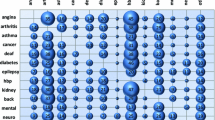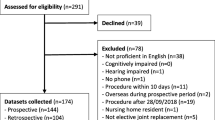Abstract
The purpose of this projectwas to compare three hospital-based measures ofco-morbidity to patient self-reportco-morbidity and to determine the relativeproportion of outcome predicted by each of theco-morbidity measures in a population ofindividuals receiving major joint arthroplasty. Baseline measures using the SF-36 generalhealth questionnaire and the Western OntarioMcMaster Osteoarthritis Index (WOMAC) wereobtained from 518 persons undergoing total kneeor hip replacement. A second measure wasobtained six months post-surgery. Co-morbiditywas calculated by summing the self-reportedco-morbidity at baseline, using both thechart-based and administrative data version ofCharlson's Co-morbidity Index, and by summingthe number of International Classification ofDiseases – Version 9 (ICD-9) codes appearingin the electronic health record. Linearregression was used to determine how much ofthe variation in outcome was explained by eachof the co-morbidity measurement methods. Self-report co-morbidity explained as muchvariation in outcome as the hospital-basedindices. Self-report co-morbidity did notperform as well as the other methods inexplaining the variance in health systemutilization. It was concluded that self-reportco-morbidity is minimally as useful asrecord-based systems when measuring the impactof co-morbidity on health related quality oflife (HRQL). This is an important finding, asprivacy legislation, the time until data isavailable and cost are all barriers to usingrecord-based co-morbidity measures.
Similar content being viewed by others
REFERENCES
Bellamy, N., W.W. Buchanan, C.H. Goldsmith, J. Campbell and L. Stitt: 1988a, ‘Validation study of WOMAC: a health status instrument for measuring clinically important patient relevant outcomes to antirheumatic drug therapy in patients with osteoarthritis of the hip or knee’, Journal of Rheumatology 15, pp. 1833–1840.
Bellamy, N., W.W. Buchanan, C.H. Goldsmith, J. Campbell and L. Stitt: 1988b, ‘Validation study of WOMAC: a health status instrument for measuring clinically-important patient-relevant outcomes following total hip or knee arthroplasty in osteoarthritis’, Journal of Orthopaedic Rheumatology 1, pp. 95–108.
Brody, H.: 2000. ‘The placebo response: recent research and implications for family practice’, Journal of Family Practice 49, pp. 649–654.
Charlson, M.E., T.P. Szatrowski, J. Peterson and J. Gold: 1994, ‘Validation of a combined comorbidity index’, Journal of Clinical Epidemiology 47, pp. 1245–1251.
Colditz, G.A., P. Martin, M.J. Stampfer, W.C. Willett, L. Sampson, B. Rosner, C.H. Hennekens and F.E. Speizer: 1986, ‘Validation of questionnaire information on risk factors and disease outcomes in a prospective cohort study of women’, American Journal of Epidemiology 123, pp. 894–900.
Deyo, D.A., D.C. Cherkin and M.A. Ciol: 1992, ‘Adapting a clinical comorbidity index for use with ICD-9–CM administrative databases’, Journal of Clinical Epidemiology 45, pp. 613–619.
Dixon, L., L. Postrado, J. Delahanty, P.J. Fischer and A. Lehman: 1999, ‘The association of medical comorbidity in schizophrenia with poor physical and mental health’, The Journal of Nervous and Mental Disorders 187, pp. 496–502.
Elixhauser, A., C. Steiner, D.R. Harris and R.M. Coffey: 1998, ‘Comorbidity measures to use with administrative data’, Medical Care 36, pp. 8–27.
Greenfield, S., G. Apolone, B.J. McNeil and P.D. Cleary: 1993, ‘The importance of co-existent disease in the occurrence of postoperative complications and one-year recovery in patients undergoing total hip replacement. Comorbidity and outcomes after hip replacement’, Medical Care 31, pp. 141–154.
Guralnik, J.M.: 1996, ‘Assessing the impact of comorbidity in the older population’, Annals of Epidemiology 6, pp. 376–380.
Hahn, R.A.: 1997, ‘The nocebo phenomenon: concept, evidence, and implications for public health’, Preventive Medicine 26, pp. 607–611.
Hamilton, S.M., D.W.C. Johnston and D.C. Voaklander: 2001, ‘An analysis of surgical outcomes following regionalization in the Canadian health care system’, Canadian Journal of Surgery 44, pp. 51–58.
Hamilton, S.M., S. Letourneau, E. Pekeles, D.C. Voaklander and D.W.C. Johnston: 1997, ‘The impact of regionalization on a surgery program in the Canadian health care system’, Archives of Surgery 132, pp. 605–612.
Hitchcock, P.B. and A. Mathews: 1992, ‘Interpretation of bodily symptoms in hypochondriasis’, Behaviour Research & Therapy 30, pp. 223–234.
Iezzoni, L.I.: 1997a, ‘Dimensions of risk’, In L.I. Iezzoni (ed.), Risk Adjustment for Measuring Healthcare Outcomes (Health Administration Press, Chicago, pp. 43–168).
Iezzoni, L.I.: 1997b, ‘The risks of risk adjustment’, Journal of the American Medical Association 278, pp. 1600–1607.
Iezzoni, L.I., S.M. Foley, J. Daley, J. Hughes, E.S. Fisher and T. Heeren: 1992, ‘Comorbidities, complications, and coding bias. Does the number of diagnosis codes matter in predicting in-hospital mortality?’, Journal of the American Medical Association 267, pp. 2197–2203.
Incalzi, R.A., O. Capparella, A. Gemma, F. Landi, E. Bruno, F. Meo and P. Carbonin: 1997, ‘The interaction between age and comorbidity contributes to predicting the mortality of geriatric patients in the acute-care hospital’, Journal of Internal Medicine 242, pp. 291–298.
Jones, C.A., D.C. Voaklander, D.W.C. Johnston and M.E. Suarez-Almazor: 2000, ‘Health-related quality of life outcomes after total hip and knee arthroplasties in a community-based sample’, Journal of Rheumatology 27, pp. 1745–1752.
Jones, C.A., D.C. Voaklander, D.W.C. Johnston and M.E. Suarez-Almazor: 2001, ‘The effect of age on pain, function, and quality of life’, Archives of Internal Medicine 161, pp. 454–460.
Katz, J.N., L.C. Chang, O. Sangha, A.H. Fossel and D.W. Bates: 1996, ‘Can comorbidity be measured by questionnaire rather than medical record review’, Medical Care 34, pp. 73–84.
Kelly, K.D., D.C. Voaklander, G. Kramer, D.W.C. Johnston, L. Redfern and M.E. Suarez-Almazor: 2000: ‘The impact of health status on waiting time for major joint arthroplasty’, Journal of Arthroplasty 15, pp. 877–883.
Kelly, K.D., D.C. Voaklander, D.W.C. Johnston, S. Newman and M.E. Suarez-Almazor: 2001, ‘Burden of illness while waiting for major joint arthroplasty’, Journal of Arthroplasty 16, pp. 351–359.
Kelly, K.D., D.C. Voaklander, D.W.C. Johnston and M.E. Suarez-Almazor: 2002, ‘Equity in waiting times for major joint arthroplasty’, Canadian Journal of Surgery 45, pp. 269–276.
Librero, J., S. Peiro and R. Ordinana: 1999: ‘Chronic comorbidity and outcomes of hospital care: length of stay, mortality, and readmission at 30 and 365 days’, Journal of Clinical Epidemiology 52, pp. 171–179.
Linet, M.S., S. Harlow, J.K. McLaoughlin and L.D. McCaffrey: 1989, ‘A comparison of interview data and medical records for previous medical conditions and surgery’, Journal of Clinical Epidemiology 42, pp. 1207–1213.
Linn, B.S., M.W. Linn and L. Gurel: 1968, ‘Cumulative illness rating scale’, Journal of the American Geriatrics Society 16, pp. 622–627.
McHorney, C.A., J.E. Ware and A.E. Raczek: 1993, ‘The MOS 36–Item Short-Form Health Survey (SF-36): II. Psychometric and clinical tests of validity in measuring physical and mental health constructs’, Medical Care 31, pp. 247–363.
Miller, M.D., C.F. Paradis and P.R. Houck: 1992, ‘Rating chronic medical illness burden in geropsychiatric practice and research: application of the Cumulative Illness Rating Scale’, Psychiatry Research 41, pp. 237–248.
Munoz, E., J. Goldstein, T. Benacquista, K. Mulloy and L. Wise: 1989, ‘Diagnosis related group ‘all payor’ hospital payment and medical diseases: financial risk and hospital cost in medical noncomplicating condition-stratified diagnosis related groups’, Archives of Internal Medicine 149, pp. 417–420.
Ontario Ministry of Health: 1990, Ontario Health Survey, User's Guide Volume 1, Documentation (Ontario Ministry of Health, Toronto).
Parkerson, G.R., W.E. Broadhead and C.K. Tse: 1993, ‘The Duke Severity of Illness Checklist (DUSOI) for measurement of severity and comorbidity’, Journal of Clinical Epidemiology 46, pp. 379–393.
Rochon, P.A., J.N. Katz, L.A. Morrow, R. McGlinchey-Berroth, M.M. Ahlquist, M. Sakkarati and K.L. Minaker: 1996, ‘Comorbid illness is associated with survival and length of hospital stay in patients with chronic disability: a prospective comparison of three comorbidity indices’, Medical Care 34, pp. 1093–1101.
Roe, C.J., N. Dodich, E. Kulinskaya and W.R. Adam: 1998, ‘Comorbidities and prediction of length of hospital stay’, Australian & New Zealand Journal of Medicine 28, pp. 811–815.
Smith, G.R.: 1994, ‘The course of somatization and its effects on utilization of health care resources’, Psychosomatics 35, pp. 263–267.
Ware, J.E.: 1993, SF-36 Health Survey: Manual and Interpretation Guide (The Medical Outcomes Trust, Boston).
Ware, J.E. and C.D. Sherbourne: 1992, ‘The MOS 36–Item Short-Form Health Survey (SF-36). I. Conceptual framework and item selection’, Medical Care 30, pp. 473–483.
Author information
Authors and Affiliations
Rights and permissions
About this article
Cite this article
Voaklander, D.C., Kelly, K.D., Jones, C.A. et al. Self Report Co-Morbidity and Health Related Quality of Life – A Comparison with Record Based Co-Morbidity Measures. Social Indicators Research 66, 213–228 (2004). https://doi.org/10.1023/B:SOCI.0000003554.03290.1a
Issue Date:
DOI: https://doi.org/10.1023/B:SOCI.0000003554.03290.1a




